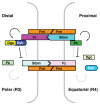Planar cell polarity in Drosophila
- PMID: 21983142
- PMCID: PMC3243030
- DOI: 10.4161/org.7.3.18143
Planar cell polarity in Drosophila
Abstract
In all multicellular organisms, epithelial cells are not only polarized along the apical-basal axis, but also within the epithelial plane, giving cells a sense of direction. Planar cell polarity (PCP) signaling regulates establishment of polarity within the plane of an epithelium. The outcomes of PCP signaling are diverse and include the determination of cell fates, the generation of asymmetric but highly aligned structures, such as the stereocilia in the human inner ear or the hairs on a fly wing, or the directional migration of cells during convergence and extension during vertebrate gastrulation. In humans, aberrant PCP signaling can result in severe developmental defects, such as open neural tubes (spina bifida), and can cause cystic kidneys. In this review, we discuss the basic mechanism and more recent findings of PCP signaling focusing on Drosophila melanogaster, the model organism in which most key PCP components were initially identified.
Figures




References
Publication types
MeSH terms
Substances
Grants and funding
LinkOut - more resources
Full Text Sources
Molecular Biology Databases
